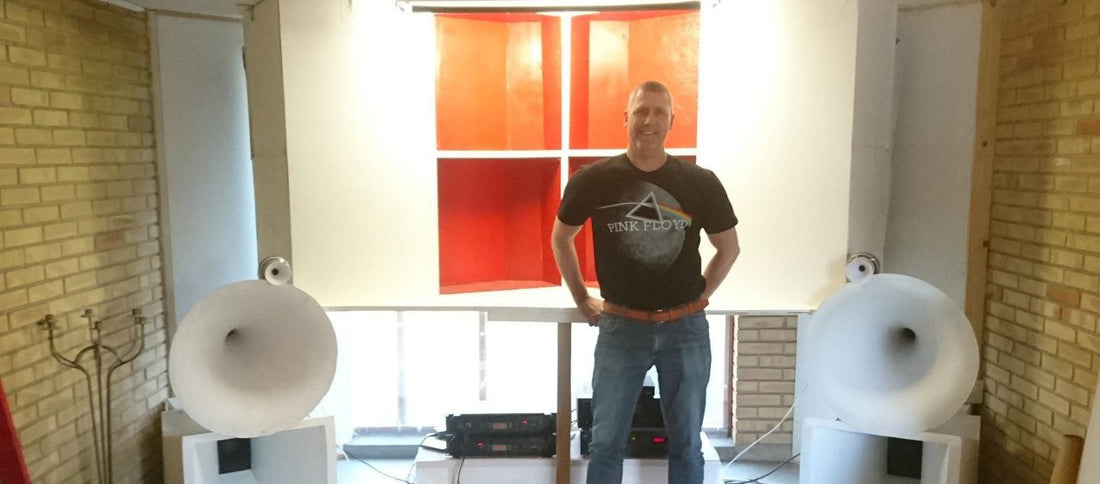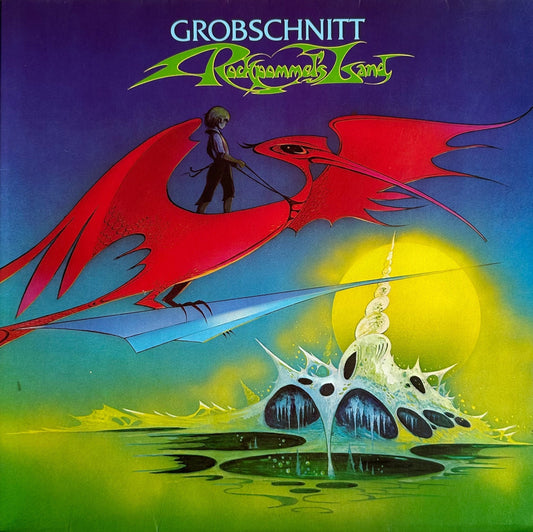Why horns?
Some might ask, why horns? These big and sometimes odd-looking creations of ancient times, can’t fit through a normal door opening, much less being set up in a living room without rearranging the whole room, instantly conflicting with the infamous WAF. Rumor also has it, they sound colored with a shouty, aggressive, nasal midrange, a harsh top end that can´t reach bat territory frequencies and are normally “integrated” with a front loaded bass driver (direct radiator bass) that sounds badly-integrated with the horn drivers, seemingly behind the horns, giving it a “slow” paced bass.
I’m sure most audio folks have experienced horn speakers that tick off some of the above description— so one could say, that there definitely is some truth to the rumors. So why even bother with horns, when you can have a little 2-way speaker like the legendary LS3/5A, that through decades has been praised, as a very accurate speaker, with a balanced sound, totally abandoning all the frequency anomalies of horn speakers? Well, first and foremost, just as all direct radiator speakers are not created equal, the same thing applies for horns. Secondly, good sound is not just about an even frequency plot (although I’ll be the first to admit, that it helps a lot on the final result). There is definitely more to the audio “picture” than meets the ears.
You see, horns are very atypical, compared to “normal” hifi speakers. Yes, both types try to reproduce the source material as faithful as possible, hence the term “high fidelity”. The main difference between them being, that horns work with the laws of physics. By doing so, they are also compelled to follow these very same laws. So for horns, form follows function.
Basically a speaker, horn or not, is a transducer that takes the electrical source signal and transform it to movements of a cone or diaphragm. This movement will produce a pressure wave which is perceived as sound. Similarly, when we speak, we send electrical signals from the brain to the vocal cords, which move and make sounds. Now put a megaphone in front of your mouth, and the sounds become much louder. You have just increased the efficiency of the system (voice/horn combo). Because the horn makes your voice so much louder, you won’t have to shout yourself to death. Same thing applies, if you put a horn in front of a loudspeaker. The speaker can relax without strain, and that is very important to good sound quality.
Put differently, a horn has two purposes.
- Loading of the driver
- Directivity control
Horns are an acoustical transformer that provide a better impedance match between the driver and the air it is coupled to. This impedance-matching is important, in order to transfer as much energy from the source (audio signal) to the load (driver). The beginning of the horn where the driver is, also called the throat, constricts the area and air volume. By doing so, the normally-low impedance of the air (because of its low density) is raised to come much closer to the high acoustical impedance of the driver. This impedance matching allows the driver to transform the soundwave, as it travels down the horn’s length, from a high pressure soundwave with a small amplitude at the throat, into a low pressure, high amplitude soundwave at the mouth, which can efficiently be radiated into the air. Overall, when a driver is properly horn-loaded, the efficiency will increase up to 75%, where 100% is theoretical max, and acoustical gain will increase with 10 dB or more. More realistically we can expect a sensitivity of 100 -110 dB/1w, with most horn loaded speakers.
This gives us an efficiency between 6.3 – 63 %. In comparison, a normal direct radiator loudspeaker with a sensitivity of 89dB/1w, will have an efficiency of 0.5%. So only a half percent of the electric energy (signal) is transformed to acoustic energy (sound). Therefore, you are losing the vast majority of your input energy (99.5%) to heat.
Directivity control plays a big role in sound reinforcement systems, where a large audience should have the same distribution of low and high frequencies. For domestic use it serves to “control” the nearfield listening space and can, to a certain point, minimize the reflections of the room. As a result, you will hear more of the speaker and less of the room.
My journey towards horns:
You have probably already guessed that I’m a horn aficionado— that’s why all the rant about horns. But I have not always been a horn lover; I haven’t always known what horns could do for the listening experience. But before I go on about my “discovery” and admiration of horns, allow me to take a quick step back in time. My reason for being in this sometimes-crazy audio world, where claims run all over the place (especially in advertisements, with no substantial arguments to back them up) is of course the music. It all starts and stops with the music. I grew up in a home full of music, mostly played back on some big Cerwin Vega 316 and an Accuphase E-302 amp. I remember my father toying around a guitar from time to time, but I was also being fed the tunes of The Beatles, Pink Floyd, Dire Straits and many of the big names of the ’60s, ’70s and ’80s, from early age. Classical music was also on the menu, although I didn’t appreciate it until reaching my 30’s. Then all the classical music I had involuntary listened to as a child, came in handy, because I could recognize it and appreciate it almost instantly.
And so, a seed of love for music was sowed as a young child. My father of course couldn’t ignore this, so he got me an old receiver and some small speakers from B&O ( yes I’m Danish!) plus a turntable and off I went, “borrowing” LP’s from my father’s collection. From around 6 years old I daily listened to the likes of The Beatles – Help, Simon & Garfunkel – Bridge Over Troubled Water, Eric Clapton – 461 Ocean Boulevard, Rod Stewart and many more. In 1982 when I was 10 years old, something special happened to my music world. My family was on a visit at some friends. They had two boys, a little bit older than me, they had bought this new album, and the cover was so cool, with some kind of a monster standing above and puppeteering the Devil. And the music was every bit as fantastic as the cover. Iron Maiden – The Number of the Beast, expanded my listening habits to include this dark, fast and feisty metal genre, even till this day.
While growing into my teens, my playback system had also grown. Compact Disc was the new black and from my confirmation money, I bought a Denon 920 amp, Denon CD player and some Cerwin Vega D7 speakers. I remember how I loved the way they could fill the room with loud music, some would probably call it noise. I was not really into the quality of the sound, yet, and more about the quantity.
I was having fun.
Then one of my friends got a set of JBL L80T. They had a very different tonality than the Cerwin Vegas, and were in general easier on the ears. Still they could rock the house pretty good. Then I got a chance to buy a used set of JBL 120TI. Next thing was to replace my Denon amp with a Pioneer A77X, which I upgraded with new and bigger electrolytic caps. I later moved on to some JBL 150A and then to a rare set of Seas DD Tower.
Around 2006, for some reason, I got the idea of trying some stand mount speakers and a subwoofer. So I found a set of Infinity Modulus, without subwoofer, so I ran them with a Dali SWA15 sub. Now I had jumped on the DSP wagon and had a Behringer DCX 2496, so I had some control over the x-over to make a better integration between the mains and the sub. At the time I didn’t pay attention to speaker efficiency, so when I wanted some fun, the delicate Infinity ribbon tweeter would bail out and the protection system would kick in. This I did find quite annoying, so the Infinity speakers were swapped for a set of System Audio 2K Master. This pairing lasted a few years until one of the bass speakers got fried at a party. The x-over had even been sat at 150 Hz, but little did it help. When push comes to shove, they couldn’t take the abuse!
At that point, I was aware that I had to re-think my whole approach to speaker type vs my demands for uncompromised high SPL. After some self-studies on the web, I settled with a DIY dipole line array, consisting of 6 x 8” upper bass drivers and 6 x B&G Neo8S planar-magnetic ribbon drivers, coupled with 2 LAT 700 subwoofers with 800 watt plate amps. Finally, I got a speaker that did not bail out, before my ears. I now knew I could never go back to “normal” speakers with sensitivity in the 87 – 90 dB range.
My need for new experiments, led me to build two big tapped horns, which I used for garden parties. They were parked in my garage during the winter months. At that time, I had seen a guy on the web (Inlowsound.com) who made horns out of paper and wood glue. Thinking it was a cool idea, I initially thought it was too complex and wasn’t there something about horns, making them sound a bit off?
In the next couple of months, compelled by the idea, I re-read the making process and it began to crystalize into my brain. Furthermore, this was a cheap DIY project: some plaster, copy paper and glue, with the biggest expense being time, the DIY guy’s greatest resource. Of course, compression drivers would be needed, but if I bought them second hand, I could always sell them again, with minimum loss. From that point of view, it felt very much in line with my thinking. A project that would be fun to try, cheap, and if I did not succeed, I could disregard it as an experiment and an experience, but not for me. On the other hand, I had this feeling, that maybe it could be my path to my “Holy Grail Of Sound”. As I saw it, I had nothing to lose, so off I went.

 Molding the horn form
Molding the horn form

This 190 Hz tractrix horn loads to around 400 Hz. As a general rule a horn loads from two times the cutoff frequency. Another general rule is, that a horn loads max 3.5 octaves. Using it to 5000 Hz is well within the range. In fact, one could, with some eq, use it to around 16 kHz, at the expense of some driver break-up above 10 kHz. An initial test run, proved very good to my ears. Even only playing 500 to 16000 Hz, I could immediately hear, that this was very different from what I was used to. The sheer power and dynamics produced by the 110 dB/1w sensitivity horn combo was overwhelming. Only some equalization would be needed to “tame” the horn a bit. I liked it a lot.
The tapped horns could only play from 30-100 Hz, so I needed an upper bass solution from 100-500 Hz. Having already gotten my feet wet with the tractrix horn, I felt that the only solution to suit the midrange/tweeter would be a horn loaded one. Luckily, Inlowsound also had a 100 Hz upper bass horn on tap. Simulating in Hornresponse, made it very easy to pick the right driver and know the shape and size of the horn.




